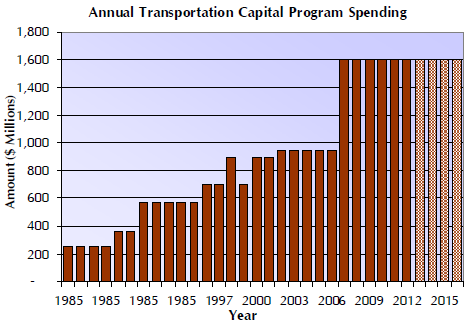Years of borrowing and a failure to raise the gas tax for over 20 years has led New Jersey’s Transportation Trust Fund (TTF)—established in 1984 to fund transportation capital projects—to be engulfed in debt payments. Yet even with this transportation crisis looming, the state of New Jersey has not acted to shore up its long-term transportation finances. Instead, last year, Governor Christie announced a five-year transportation funding plan for the fiscal years 2012-2016 that has been widely criticized as unsustainable.
Now, a new Office of Legislative Services (OLS) report has given the patchwork funding plan’s critics even more credibility: the paper, composed by a nonpartisan government entity, outlines four unresolved issues for the future of New Jersey’s transportation funding:
- The Transportation Trust Fund needs its bond cap raised: TTF legislative authorization to raise the bond cap is necessary before fiscal years 2013-2016 of the five-year plan can be completed. According to the TTFA funding plan for the fiscal year 2013, $986 million in TTF Authority bonding credit is needed to meet the year’s budget needs, but only $326.3 million in bond authority remains from the last reauthorization of the TTF in 2006.

- There is a lack of dedicated revenues: The current five-year program relies heavily on general fund transfers without identifying new dedicated revenue sources. As a result, transportation funds are not protected against “redirection or reduction” and are subject to budgetary action each year. This means that funding from the general fund can only be assumed through the 2016 fiscal year.
- New Jersey’s plan for its transportation network keeps capital program expenditures at their current levels: Since 1984, the TTF has never gone more than five years without increasing the size of the capital program. The current capital program keeps appropriation at a constant level of $1.6 billion/year for 10 years (2007-2016), instead of increasing it to meet the rising costs of projects. Failing to increase the size of the capital program actually means that the state will be contributing less in real dollars to its transportation system because $1.6 billion in 2016 dollars is significantly less than $1.6 billion in 2007 dollars.
- Funding is not assured after 2016: The five-year capital program’s funding comes from a variety of sources, including toll hikes from the New Jersey Turnpike Authority meant for the cancelled Access to the Region’s Core project and one-shots from the Port Authority of New York and New Jersey for certain projects. Neither of these two sources are permanent commitments that will last beyond 2016, which will leave a funding gap of at least $692 million. For the 2017 fiscal year and beyond, New Jersey will have to find a way to come up with new money simply to maintain current funding levels. Unless new dedicated funding is introduced, there will be an even heavier reliance on unstable, unpredictable general fund transfers.

Good story –
Illustrates how CHristie’s ideological stance against both government and new revenues (tax or fees) harms the interests of the entire state of New Jersey.
And not just transportation is at stake – cars and trucks pollute the air and cause NJ to fail federal ozone and fine particulate standards set to protect public health.
Additionally, cars cause about a third of greenhouse gas emissions.
We gotta get people out of cars and onto public transit – and that will cost money!
See recent coverage of NJ Clean Air Council:
http://www.njspotlight.com/stories/12/0411/2052/
The reality is that New Jersey miles driven has declined by over 5% so why is Christie increasing highway spending by 12% for more highway expansion. The reality is we are in the age of Peak Oil and Limits to Growth – if you think $4 per gallon gas is high wait until it hits $6 and $7!
Yet New Jersey should be the leader in Green Transit – we are the most densely populated State, more densely populated than China and we already have 996 miles of Rail.
Yet since 2006 when former Gov Corzine cut Morris Line Hoboken weekend service by 50%, then cut Hoboken weekday service in 2008 by 30% and Gov Christie continued cutting 7 more trains in 2010 we are cutting trains on lines already built and paid for! We have the Boonton Line with no weekend and off-peak service, Gladstone Branch with 3 1/2 hour service gap from 5 to 8:30 PM weekdays, etc.
The cheapest thing we can do is run the trains and make the best use of the capital spent on the Rail lines and cars.
Who cares about the transportation fund in 2016? I’ll be running for President by then.
[…] to make sure transportation spending is not scaled back.” Unsustainable borrowing has already buried New Jersey’s Transportation Trust Fund in debt payments, and this certainly won’t help. May […]
[…] a month after the state’s Office of Legislative Services released a report revealing just how bleak the future is for transportation funding in New Jersey. Assuming the adoption of the treasurer’s […]
[…] It is abundantly clear that without new revenue sources or an increased reliance on debt, the state will not have enough money to maintain current funding levels, let alone meet future transportation […]
[…] found the courage to raise revenues for the Transportation Trust Fund–Even though the TTF was broke before the storm, the devastation wrought by Superstorm Sandy has still not convinced Governor […]
[…] Notably absent from the governor’s address was any mention of how to pay for the rebuilding outside of relying upon federal dollars. Even that will not address New Jersey’s needs beyond Sandy rebuilding. Governor Christie must lead the way to identifying a sustainable funding source for the bankrupt Transportation Trust Fund. […]
You are my breathing in, I have few web logs and rarely run out from to brand.
I got what you mean , appreciate it for putting up.Woh I am pleased to find this website through google. “Since the Exodus, freedom has always spoken with a Hebrew accent.” by Heinrich Heine.
[…] Christie to fund the Transportation 5-Year Capital Program will be gone, leaving the program with a $1.8 billion hole over the next 5 years – and that’s just to maintain current spending […]
[…] immediate action — and with the obvious funding crisis looming on the horizon — New Jersey will see no relief from continued deteriorating bridges and […]
[…] the sofa for change each year to meet current promised spending levels (which is at an historically stagnant level), the lack of a new revenue source, such as a gas tax increase, puts the State in a bind to fund […]
[…] pressure is further exacerbated by the $692 million funding gap expected in 2017 after the expiration of temporary Turnpike Authority and PANYNJ […]
[…] With all this borrowing for Turnpike Authority (and with the Transportation Trust Fund being broker than broke), New Jersey is driving down a (wide and congested) road to financial […]
[…] Christie didn’t mention how much the state will be investing next year. New Jersey has a historic trend of stagnant funding for the last decade, which means the state’s buying power shrinks as the cost of materials […]